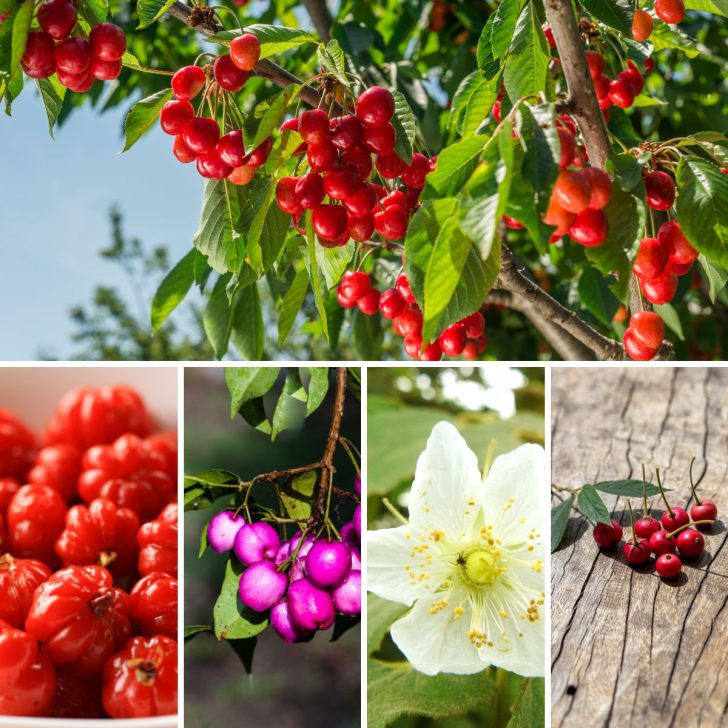“Tropical cherry tree” is a colloquial term that refers to various types of cherry-like fruits that grow in tropical and subtropical regions, characterized by their ability to thrive in warm climates year-round.
These are not actually true cherry trees of the Prunus genus that most people in North American think of as cherries.
There’s one true cherry that grows well in subtropical climatic zones. In this article we outline both, the cherry-like tropical cherry trees as well as the one sub-tropical cherry tree.
True Cherry Trees
The genus Prunus, which includes true cherries, is largely temperate and does not include tropical species. The Capulin Cherry (Prunus salicifolia) is somewhat unique in the genus because it can thrive in subtropical climates, but it’s not considered a true tropical plant.
True cherry trees, including those in the Prunus genus, typically require a period of cold weather each year to regulate their growth cycles, a characteristic known as “chill requirement.” This makes them unsuitable for the year-round warm climates found in tropical regions.
So while there are cherry trees that can grow in the warmer areas of North America, the Capulin Cherry, for instance, can thrive in subtropical climates. However, there are no Prunus cherry trees native to or that are considered truly tropical. The cherry trees often referred to as “tropical” belong to different genera and are not true cherries from a botanical standpoint.
These trees, known for their delectable fruits, vibrant blooms, and aesthetic appeal, are well-suited to the heat and variable rainfall of tropical regions. In this article, we’ll explore various tropical cherry tree varieties, examining their characteristics, cultivation needs, and the unique qualities that make them notable in the world of botany.
List of Subtropical and Tropical Cherry Trees
6 Popular Tropical Cherry Trees (That Aren’t True Cherries)
Acerola Cherry (Malpighia emarginata)
- Scientific Name: Malpighia emarginata
- Common Names: Acerola cherry, Barbados cherry, West Indian cherry
- Hardiness Zones: 10-11
- Temperature range: 50-85°F (10-29°C)
- Drought tolerant: Yes
- US States: Florida, Hawaii, Puerto Rico, Virgin Islands
- Bloom Time: All year
- Fragrance: No
- Pollination: Self-fertile
- Ripens: Year-round
- Fruit: Bright red, cherry-like fruits
- Edible parts: Fruit, leaves, flowers, stems, roots, and bark (often used in teas and traditional medicines)
- Medicinal uses or benefits: High in vitamin C, antioxidants; used in traditional remedies for various ailments
The Acerola, also known as West Indian or Barbados cherry (Malpighia emarginata), is a beacon of health and vitality in tropical landscapes, revered for its vitamin-rich fruit and medicinal properties. Its resilience and year-round fruiting make it a valuable, multifaceted gem in any garden setting.
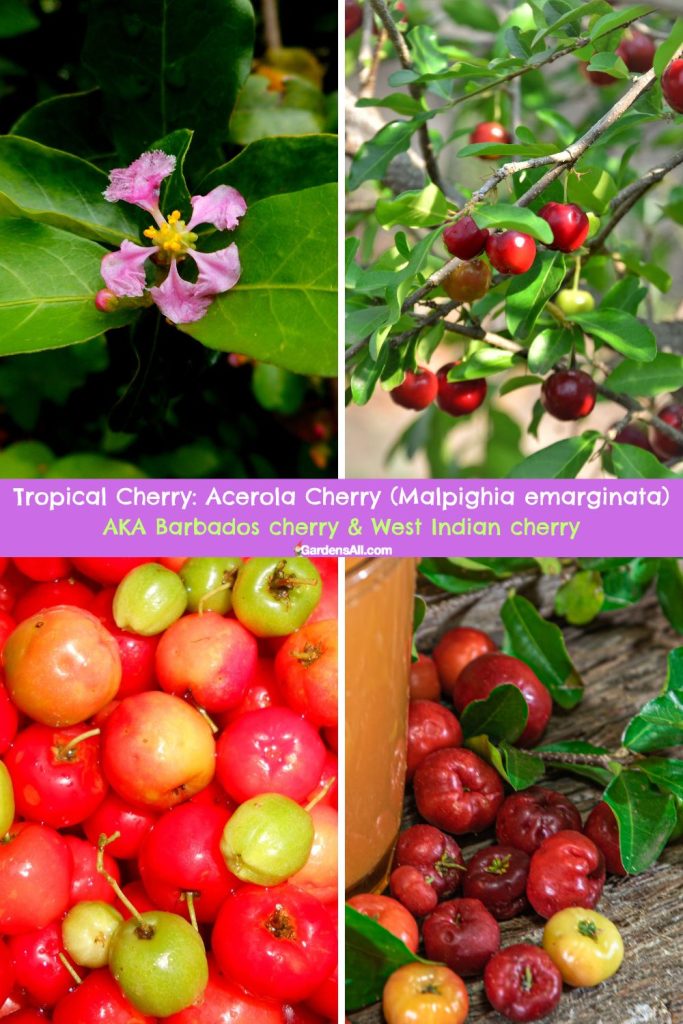
Brush Cherry (Syzygium paniculatum)
- Scientific Name: Syzygium paniculatum
- Common Names: Brush cherry, Magenta cherry
- Hardiness Zones: 10-11
- Temperature range: 60-85°F (16-29°C)
- Drought tolerant: Moderately
- US States: Primarily grown in Florida and Hawaii
- Bloom Time: Spring and summer
- Fragrance: Yes; sweet and fragrant
- Pollination: Requires cross-pollination
- Ripens: Summer
- Fruit: Small, pink to red berries
- Edible parts: Fruit, leaves, and seeds. The fruit is edible and is often eaten fresh, used in cooking, or made into jams and jellies. The leaves and seeds can be used in traditional medicine and teas.
- Medicinal uses or benefits: The leaves have been traditionally used to treat various ailments, often related to digestion and inflammation. The seeds, less commonly used, have been employed in various traditional medicine practices as well.
The Brush Cherry is notable for its sweet, edible fruits and seeds. The leaves and flowers, also edible, are used in various traditional remedies, highlighting the plant’s diverse uses.
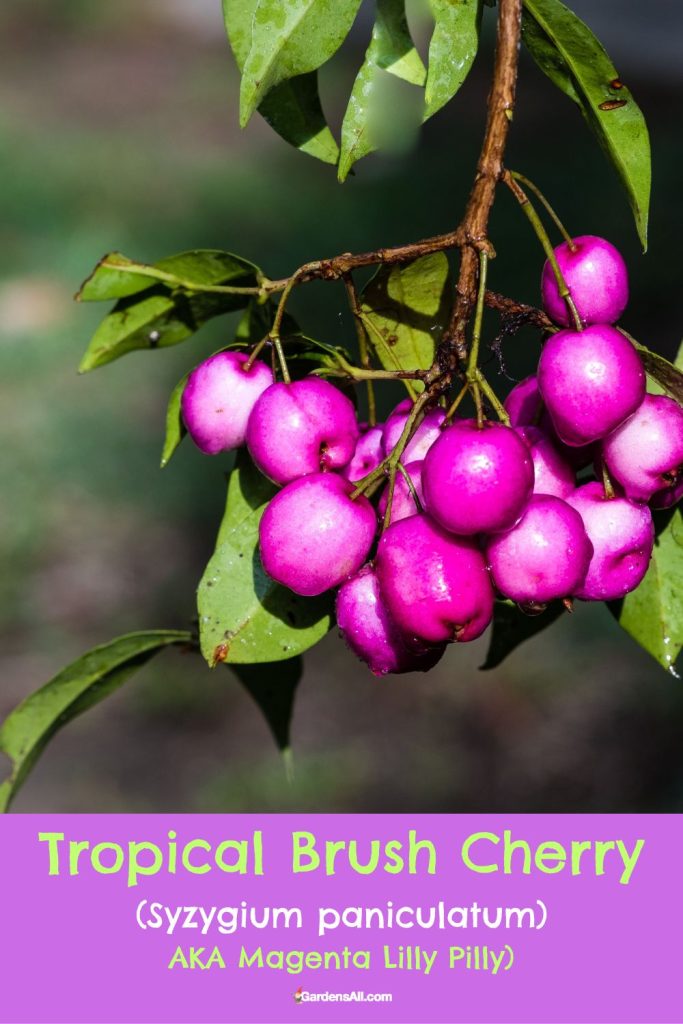
Capulin Cherry (Prunus salicifolia)
This is the one true tropical cherry tree that can be grown in subtropical and possibly tropical zones 9-11.
- Scientific Name: Prunus salicifolia
- Common Names: Capulin cherry, Mexican black cherry
- Hardiness Zones: 9-11
- Temperature range: 50-90°F (10-32°C)
- Drought tolerant: Moderately
- US States: Grown in subtropical areas, not widespread in the US
- Bloom Time: Early spring
- Fragrance: No
- Pollination: Self-fertile
- Ripens: Summer
- Fruit: Sweet, dark fruits that are red to black and are often used in desserts and jams.
- Edible parts: Fruit; young leaves can be cooked, and older leaves dried for teas. The bark can also be dried for infusions and is used in traditional remedies.
- Medicinal uses or benefits: Antioxidant properties; Bark has been used traditionally to treat fever and respiratory issues.
The Capulin Cherry (Prunus salicifolia) is somewhat unique in the genus because it can thrive in subtropical climates, but it’s not considered a tropical plant per se.
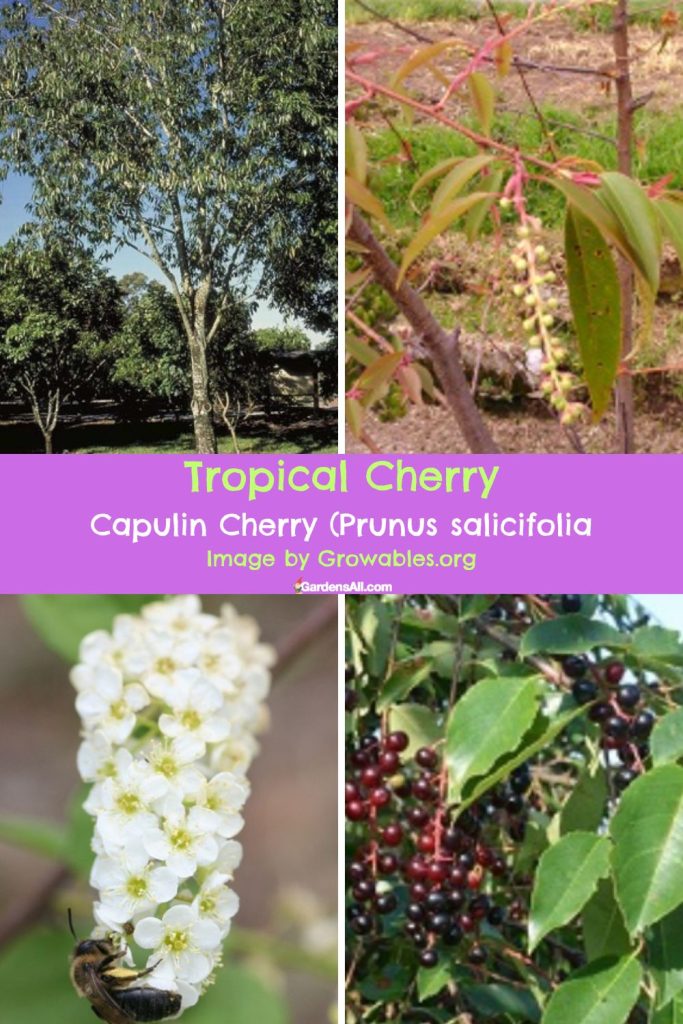
Images by Growables.org
Florida Cherry (Eugenia uniflora)
- Scientific Name: Eugenia uniflora
- Common Names: Florida cherry, Surinam cherry, Brazilian cherry
- Hardiness Zones: 9b-11
- Temperature range: 60-85°F (16-29°C)
- Drought tolerant: Yes
- US States: Florida
- Bloom Time: Mid-spring
- Fragrance: Yes; sweet and fruity
- Pollination: Self-fertile
- Ripens: Late spring
- Fruit: Red to black, pumpkin-shaped berries
- Edible parts: Fruit, leaves, and seeds (leaves and seeds used in teas and traditional medicines)
- Medicinal uses or benefits: Leaves are often used for tea believed to have digestive benefits.
The Florida cherry is notable for its unique, pumpkin-shaped berries and pleasant fragrance. It’s a popular choice for gardens due to its edible fruit and traditional medicinal uses.
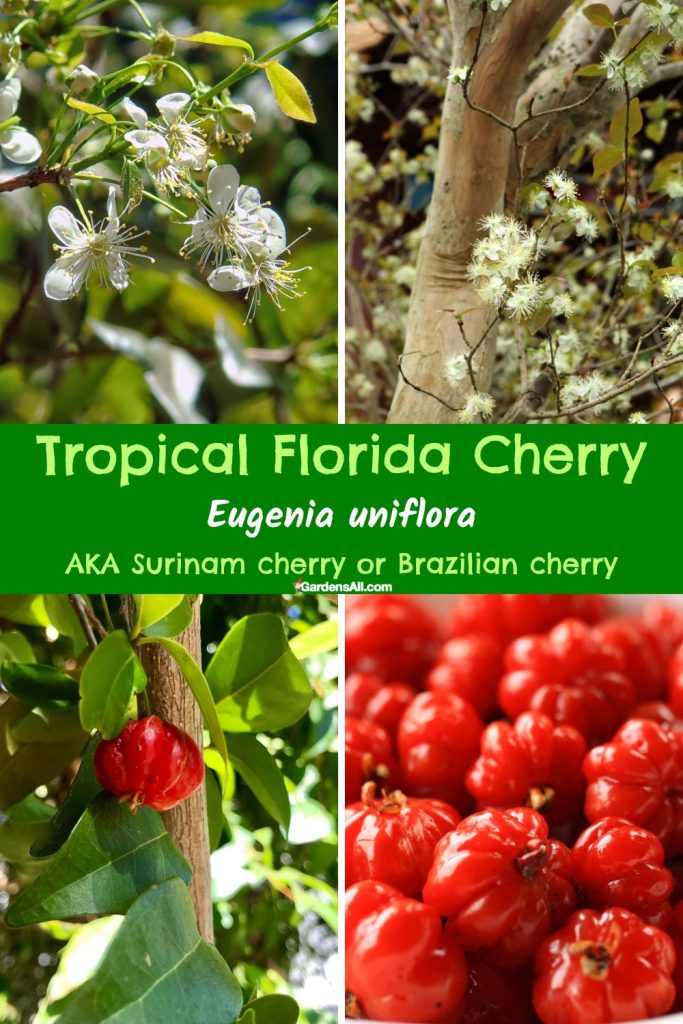
Jamaican Cherry (Muntingia calabura)
- Scientific Name: Muntingia calabura
- Common Names: Jamaican cherry, Panama berry, Singapore cherry
- Hardiness Zones: 10-11
- Temperature range: 60-100°F (16-38°C)
- Drought tolerant: Yes
- US States: Florida, Hawaii
- Bloom Time: Spring and summer
- Fragrance: Yes; slightly sweet
- Pollination: Self-fertile
- Ripens: Summer
- Fruit: Small, red, cherry-like fruits with a sweet flavor.
- Edible parts: Fruit, leaves, and flowers (leaves and flowers are often used in teas and traditional medicines).
- Medicinal uses or benefits: Leaves and flowers have anti-inflammatory properties and are used in traditional medicine for pain relief, colds, and flu. The fruit is also known for its nutritional value.
Each of these tropical cherry trees contributes uniquely to the diversity and richness of tropical gardens. They’re beautifully ornamental and wonderfully useful and beneficial in myriad ways. These are definitely fruits worth growing!
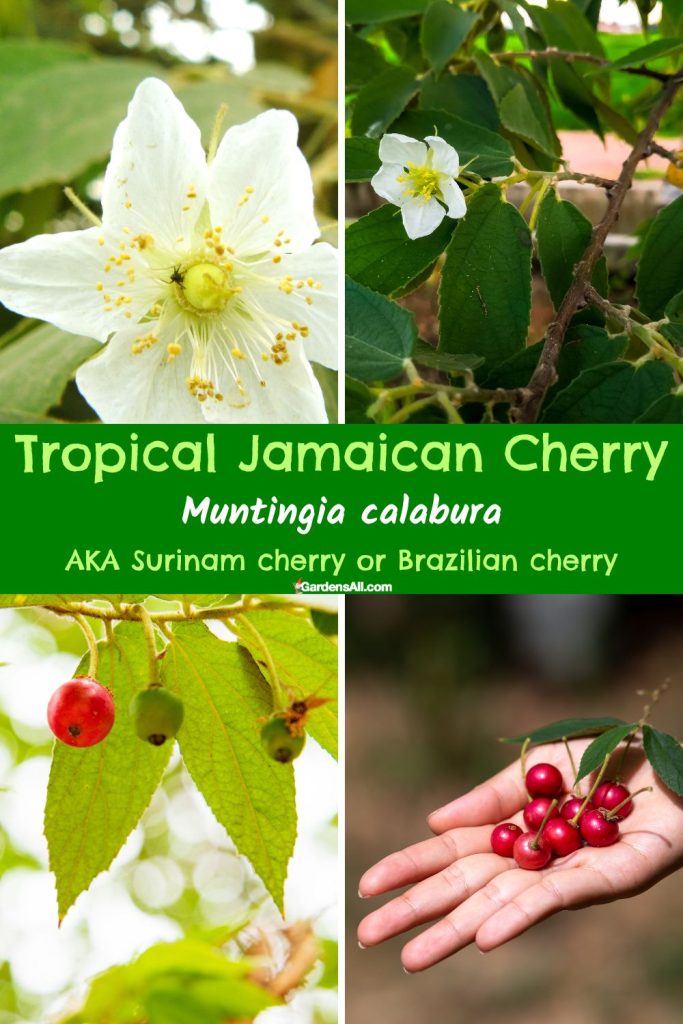
If you’re in a colder area, (or have friends that are), you may be interested in our article on cold hardy cherry trees.
If you’re in a tropical climate, you’re lucky to have a long list of plants you can grow, and often, year round! If you’re not already growing avocados, papayas and mangos for instance, the leaves are also beneficial beyond the wonderful fruits!
For more on that, you may enjoy our articles on avocado leaves benefits and also mango leaves benefits. Our next favorite tropical fruit tree is the Meyer lemon tree.
I’m LeAura Alderson, a garden, herb and plant enthusiast with a passion for discovering the many edible and medicinal benefits of the plants all around us, including the weeds! I’m a writer, editor and media publisher for our family of websites.
While I was certified in fitness and life coaching, I am NOT a health practitioner. However, I’m a lifelong health enthusiast, with a keen interest in healthy, organic foods and making home remedies and the content we share is from our own experience and usage as well as that extracted from scientific research so that you can explore further on your own.
Always seek the advice and guidance of your health practitioners first and foremost.
As a family we’re steadily expanding our gardening, experimentation and knowledge around all things gardening, edible landscaping, fresh organic foods and self sustainability with farming in our future. I also own and manage iCreateDaily.com, a site all about transformation through creation, and the power of positivity, optimism and mindset.

